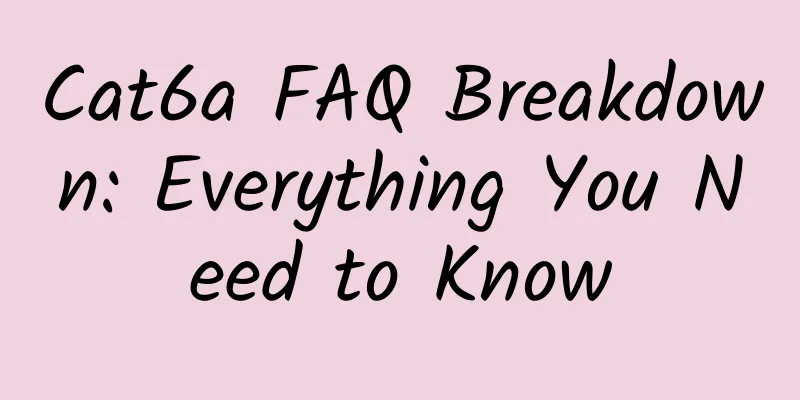Cat6a FAQ Breakdown: Everything You Need to Know

What is Cat6a Ethernet Cable?Cat6a cables represent an enhanced version of Cat6 cables, consisting of twisted-pair copper wires that support high-speed data transmission up to 500 MHz. This level of enhancement is twice that of regular Cat6 cables. Cat6a cables typically have a thicker outer jacket, larger inner space, and tighter twisting. As a result, these components help reduce noise and crosstalk during high-speed transmission. What is Shielded Cat6a Cable?There are three shielding categories for Cat6a cables, all of which are very similar. Adding a foil shield around the core or outer jacket increases the size of the cable, providing protection from EMI and external noise.
Cat6a FAQ Breakdown: Everything You Need to Know Is it necessary to shield Cat6a?In a home or small business, unshielded Cat6a cables usually work fine. Shielded Cat6a cables are required when the network is crowded. This means that if you are going to install more than at least two other cables in the same space, you need shielded cables. What is the cause of return loss in copper cabling systems?Return loss in copper cabling links stems from impedance mismatches between components or slight variations in impedance along the length of the cable. Other contributing factors include kinked or damaged cables, improper termination practices (such as unnecessary untwisting of pairs at the termination point), and the presence of water within the cable. How do I know if my cable is Cat6a?Cat6a and Cat6 cables have their identifier printed on the cable jacket - Category 6a or Category 6, respectively. Another quick way to tell the two apart is to notice that Cat6a cables are thicker and bulkier than Cat6 cables. What are the capabilities of Cat6a?Cat6a supports 10GBASE-T up to 100 meters, ensuring compatibility with the fastest twisted pair Ethernet applications on the market. It adheres to standards for full channel lengths (such as TIA-568 and ISO/IEC 11801), so it is highly recommended for new buildings, office networks, and data centers. Cat6a is also backward compatible with Cat6, Cat5e, and Cat5, providing a powerful solution for future network upgrades. Frequently Asked Questions about Cat6a Cable Applications(1) Can I run HDMI over Cat6a? When transmitting HDMI signals through structured cabling, Cat6a is a good choice. Cat6a's shielding is suitable for audio-visual transmission, providing better anti-interference protection for audio-visual signals. Many audio-visual product manufacturers have developed special twisted pair cables for HDMI transmission. The performance of these cables is almost the same as Cat6a. In the transmission link, the source device converts the HDMI signal into a format suitable for transmission over Cat6a cables. The receiving end then converts the structured cable back to HDMI. (2) Can I run Cat6a next to a power supply? If it is shielded Cat6a, you can place it next to the power lines, but even then, keep 8 inches between them. Unshielded cables may experience data and bandwidth loss when run close to power lines. PoE cables running close to power lines may cause heat and fire hazards. (3) Can Cat6a be used for making phone calls? Cat5e, Cat6, and Cat6a are all suitable for modern VoIP systems, so it really depends on your needs. If you are looking for a cable that can handle today's phone systems, Cat6a is a good choice. However, remember that your overall cabling needs should be considered when making the final decision. (4) Can I mix Cat6 and Cat6A cables? Yes, Cat6 and Cat6a can be used together in the same setup, but the bandwidth that Cat6a can support may be bottlenecked by using a cable that supports a lower bandwidth, which will affect your speeds. (5) What happens if the shield cable is not grounded? An ungrounded shielded cable will not work effectively. Any interruption in the path will increase impedance and reduce the effectiveness of the shield. (6) How many Cat6a cables can be bundled together? Since Cat6a is usually 23AWG, this means that Cat6a, 75C cables can be used in bundles of 192. Cat 6a and Power over Ethernet (PoE) FAQs(1) Are there any risks of temperature rise and fire caused by cables using the 802.3bt standard? The temperature rise of individual conductors is one of the factors that contribute to elevated temperatures and fire risk. Generally speaking, smaller gauge conductors, such as those in Cat5 cables, result in higher temperature rises than larger gauge conductors, such as Cat6a. For new PoE installations, Cat6a is recommended to minimize temperature rise. The number of cables in a bundle also affects heat accumulation, and deployment strategies can help address PoE cable overheating issues. (2) Why is Cat6a more suitable for PoE? For PoE devices, it is more advantageous to use Cat 6A cables as the cables with larger conductor diameter help in reducing resistance and keep power wastage to very low due to lower temperature rise compared to smaller gauge cables like Cat 5e or Cat 6 cables. (3) How far can PoE be transmitted via Cat6a? Cat6a cable speeds can be sustained over distances of up to 100m. This is a significant upgrade over CAT6 cables, which can only relay 10 Gbps speeds over a range of 33-55m. Category 6a and Other Category Cabling FAQs(1) Why choose Cat6a instead of Cat6? Cat6 cable is rated at 250 MHz, so the maximum length is reduced (37-55 meters) when used in 10GBASE-T applications. Cat6a has a frequency of 500 MHz, doubling this capability and extending the operating distance of 10GBASE-T to 100 meters. We believe that cabling decisions should be made with an eye on the long term to avoid unforeseen costs and challenges. Therefore, Cat6a is more suitable for the future. (2) Is Cat6a better than Cat 7? The performance difference is minimal. Both Cat6a and Cat7 support 10GE on 10-meter channels. Cat6a has a maximum frequency of 500 MHz, while Cat7 has a maximum frequency of 600 MHz. The difference is that Cat7 requires non-RJ45 connectors and thick shielding (which needs to be grounded to work properly). Without significant performance improvements, deploying Cat7 may be more expensive. Therefore, Cat6a has a higher cost-performance ratio. (3) Why is Cat6a more sustainable than Cat5 or Cat6? Cat6a has a longer lifecycle than Cat5 or Cat6. It can support multiple generations of bandwidth growth and power requirements, reducing product turnover and associated environmental impact. It is therefore more economically and ecologically sustainable than Cat5 or Cat6. |
<<: 5G cybersecurity market to reach $16 billion by 2028
>>: Why do you need a managed switch?
Recommend
2021 Apps UP Competition | Huawei Chen Lifang: The stars will never fade, let’s walk hand in hand
[Beijing, June 10] The 2021 Huawei HMS Global App...
OneTechCloud: 20% off on all VPS monthly payments starting from 22 yuan/month, Hong Kong CN2&CMI/US CN2 GIA&9929/High Defense optional
OneTechCloud (Yikeyun) offers a 20% discount code...
Why are private operators becoming more and more popular while the three major operators are being neglected?
In 2013, the Ministry of Industry and Information...
The role of LoRaWAN and IoT in optimizing asset management
The role of the Internet of Things (IoT) and LoRa...
spinservers: 10Gbps bandwidth high-end server, monthly payment of $139, dual E5 2630Lv3/256GB/2×1.92T SSD/Dallas
spinservers has sent us new promotional machines,...
Wi-Fi signals are invisible and intangible, but there are actually traces to follow
Labs Guide Have you ever encountered the phenomen...
Akamai launches first NFT artwork to visualize Internet activity
May 25, 2022 - Akamai Technologies, Inc. (NASDAQ:...
Tudcloud: Hong Kong VPS with 70% discount for the first month starting at $2.7, with options for high bandwidth or unlimited traffic
Tudcloud has released this month's promotion....
How does DNS work? See how this "translator" converts domain names and IP addresses
[[277197]] 1. What is DNS? DNS (Domain Name Syste...
5G applications with over 100 million users have crossed the starting line
The development of 5G networks is in full swing. ...
BudgetVM: Los Angeles/Dallas/Chicago/Japan/Hong Kong dedicated servers starting at $49 per month
BudgetVM is a local data center founded in 2015. ...
Sharktech cloud server 35% off annual payment starting at $33, 2G memory/40G hard drive/4TB traffic/multiple computer rooms available
Sharktech, also known as SK or Shark Data Center,...
ChatGPT and 5G messaging: the perfect combination of new artificial intelligence and new communications
At present, the hottest topic is none other than ...
SD-WAN is just the first step in WAN automation
Just like self-driving cars, IT networks are beco...
Six advantages of deploying SD-WAN
With the increase in data analysis, media traffic...









